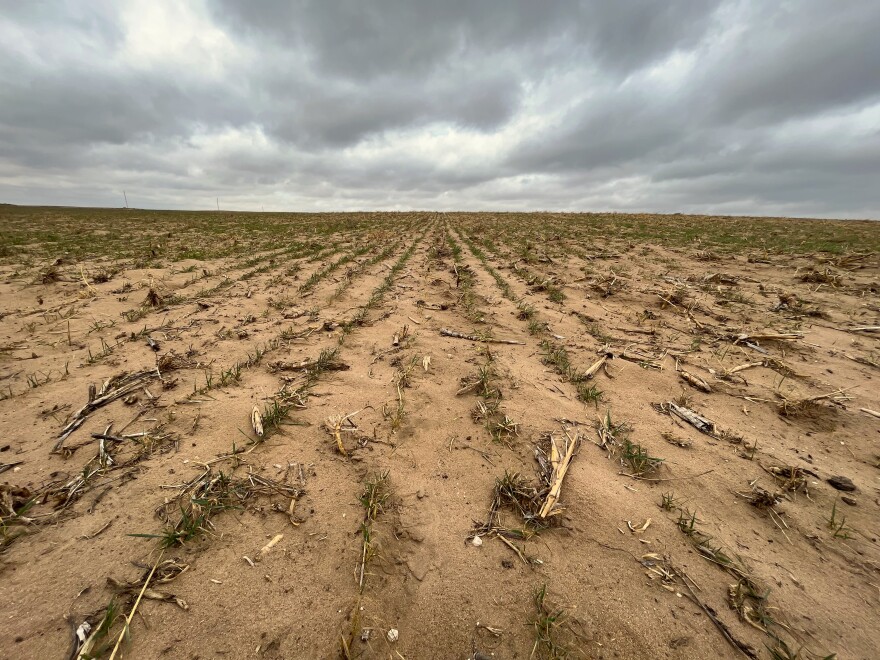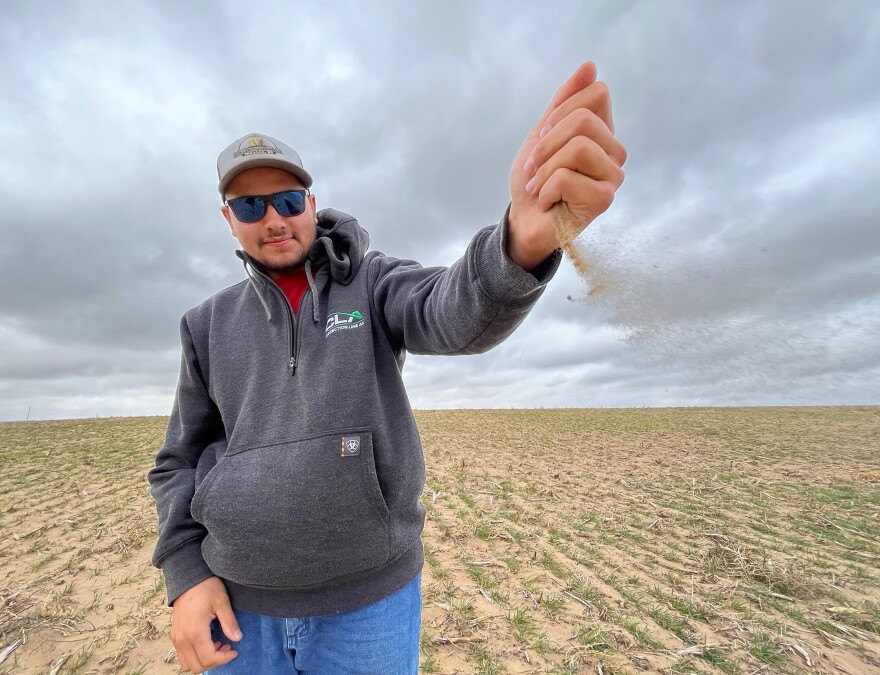LA CROSSE, Kansas — On G.W. Johnston’s ranch in west-central Kansas, the grass never got green this summer.
So he's had to buy hay to keep his cattle alive — in the middle of a widespread drought that's pushed those hay prices way up.
He could sell all his cattle, at the cost of leaving behind the work that's defined his life. Watching his calves arrive in the spring, he said, is what counts as his therapy during a stressful year like this.

But he's out of grass.
So he came here to the La Crosse Livestock Market to auction off 52 of his calves.
“You always think it’s gonna get better,” Johnston said. “Out of 60 years since I’ve been in the business, I’ve never run into it this bad.”
Johnston’s story marks just one example of the countless ways this historically dry, hot, windy year is wreaking havoc from coast to coast.

Drought now covers more than half of the continental U.S., and its ripple effects touch everything from the food we eat to the air we breathe to the water we drink. In one of the hardest hit regions, the Great Plains, there’s not much relief in sight.
In Missouri, the drought is cracking home foundations. In Minnesota, it’s killing Christmas trees. Low water levels have shut down a hydroelectric plant in Iowa and stranded barges on the Mississippi River.
Frank Seidel, who owns the La Crosse cattle auction, has seen his share of bad droughts in this semi-arid part of the world. But never like this.
“Not to this severity,” Seidel said. “You look at them pastures, and they’re just grubbed down to nothing.”

- One year after wildfires, Kansas ranchers vow to ‘get by ... somehow’
- How bad was the 2022 drought? For these 7 Kansas communities, it was the driest on record
- This city in Kansas really conserves its water, but that still might not be enough to survive
- Western Kansas wheat crops are failing just when the world needs them most
- How the drought killing Kansas corn crops could make you pay more for gas and beef
- Up to 1 million birds count on Kansas wetlands during migration. Drought has left them high and dry
- As fertilizer pollutes tap water in small towns, rural Kansans pay the price
- A hotter, drier climate and dwindling water has more Kansas farmers taking a chance on cotton
Kansas cattle would normally be grazing on a buffet of prairie grass over the past few months. But in one of the driest, hottest summers on record in western Kansas, oppressive drought scorched pastures across the region.
That left ranchers with a tough choice this fall: bring in expensive feed to get your livestock through the winter or sell however many cattle you must to keep your livelihood afloat.
“It’s everybody. There’s no one excluded from it,” Seidel said. “The conversation is always, ‘I ain’t got enough feed. I don’t have enough feed. So, I can’t keep them all.’”

This livestock market has auctioned off 12,000 more cattle this year than it did by this point last year, Seidel said, an increase of nearly 20%.
So many ranchers were calling Seidel clamoring to thin their herds in the late summer that he had to double the number of auctions from every other week to every week.
In the hallways outside the La Crosse auction ring, the historic gravity of this year’s drought comes into focus.

Max Prose’s ranch in Lane County got less than half of its paltry average rainfall this year. In the 71 years he’s farmed, this is the first that his land has no moisture left in its soil. He had to sell off his calves in August.
“There’s places in my pasture that didn’t get any rain at all,” Prose said. “The cactus have died.”
Gene Tilton, who farms and raises cattle near Quinter in northwest Kansas, said the only thing that could turn this drought around is a blizzard like the one that helped claw the region out of a similar drought 65 years ago.
“It’s dry. … Dry as it’s been since 1955,” Tilton said. “I was here.”

With roughly three-quarters of U.S. cattle currently in drought-stricken areas, ranchers from Texas to Montana face these same hard choices. And the impacts of those choices touch plenty of folks who’ve never seen an auction ring.
Because so many ranchers have to sell their animals months or even years ahead of schedule, there’ll be a shortage of cattle going to market next year. That will mean higher beef prices at the grocery store.
“That hamburger won’t be in the industry for the next two years,” Seidel said. “It’s gone.”

‘When’s it gonna stop?’
As climate change fuels more frequent, more intense droughts nationwide, it’s hard to count all the ways this parched year is transforming people’s lives.
Just ask the person whose job it is to keep track of the drought’s impacts: the National Drought Mitigation Center’s Denise Gutzmer.
“I’m just swamped,” Gutzmer said. “I can work nonstop and still not be done.”
Deadly wildfires. Choking dust storms. Decimated crop harvests.
The amount of the country covered in drought and abnormal dryness this fall, Gutzmer said, is the most in the history of the Drought Monitor. More than half of the continental U.S. is now covered by some level of drought.

The impacts this year stretch even farther across the map, Gutzmer said, than the last major drought in 2012 — from fanning wildfires in Hawaii to drying up water supplies in California to rotting the wood pilings that support buildings in Boston.
“It just all snowballs so quickly,” Gutzmer said. “It’s just been horrifying.”
In the grasslands of Kansas, the extreme heat has threatened another creature that shares the state’s pastures with cattle: birds.
Iconic prairie songbirds like meadowlarks and grasshopper sparrows build their nests down in the grass. Robert Penner, bird conservation manager with The Nature Conservancy, said that as ground temperatures climb north of 100 degrees, it can roast the eggs where they lie.
“The eggs were just basically cooked,” Penner said. “The adults just gave up on them because the temperatures were too high.”
A lack of rainfall has also dried up the Kansas wetlands that hundreds of thousands of birds use as vital stopover points during their long flights south for the winter.

In the 26 years Penner has worked in central Kansas, he said, it’s hard to think of another time when the area’s wetlands were this dry, especially this late in the year.
With no water in the Cheyenne Bottoms wetlands, for instance, he’s spotted migrating ducks and geese paddling around the sewage lagoons of a nearby town. He’s seen smaller birds gathering at livestock water tanks.
For shorebirds — some of which migrate thousands of miles and weigh only a few ounces — not being able to rest and refuel at wetlands that meet their specific food and habitat needs could push them beyond their limits.
“If they can’t stop and feed somewhere, they’re in trouble,” Penner said. “They’re not going to make it.”
I saw a bunch of sad corn fields like this one while I was in Finney County.
— David Condos (@davidcondos) July 26, 2022
The months-long drought — paired with recent 100-degree temperatures — has fried a lot of the #westernkansas corn crop. pic.twitter.com/ivcXV1xTDG
Nearby, parts of southeastern Kansas and Oklahoma saw flash droughts rapidly develop over the summer as record-low precipitation totals paired with sweltering heat.
When a reservoir that provides drinking water for more than 1 million people in Oklahoma City dropped several feet below its normal level this summer, the city had to bring in billions of gallons from another lake 100 miles away. It’s the first time that’s happened in a decade.
“We hoped that one water draw would be enough, and that we’d get a lot of rain after that,” utility department spokesperson Michelann Ooten said. “But that didn’t happen.”
So the city drew another 4 billion gallons from that reservoir, Canton Lake, this fall.

For the people who live in rural western Oklahoma near Canton Lake, watching that much water flow away in the middle of a drought was hard to swallow.
Curtis Hoskins, president of the Canton Lake Association, said it’s a critical blow to the area’s recreational tourism economy. The last time Oklahoma City drew away billions of gallons a decade ago, low lake levels forced businesses to close.
“Everybody was pretty upset, you know, because they’ve seen it happen before,” Hoskins said. “Everybody’s gun-shy that they don’t have control of the water.”
And cities aren’t the only ones scrambling for more water.
As the lack of rainfall pushes farmers to pump more water from underground aquifers to irrigate crops, parts of Kansas and Nebraska are considering new pumping limits.

Nate Jenkins, assistant manager of the Upper Republican Natural Resource District in southwest Nebraska, said the proposed limits in his area aren’t a direct response to this particularly dry year. But in a region where so much of the economy bends to the whims of the weather, the reality of life without water is easy to envision.
“It creates some worry,” Jenkins said. “Everybody knows farmers or is a farmer, so they know what they're struggling with.”
The depletion of the Ogallala aquifer in the High Plains isn’t a new problem — roughly a third of the water under Kansas has already disappeared since European settlement, largely thanks to the development of irrigated farming. And some of the districts in charge of managing that underground water have already put plans in place to slow down the aquifer’s decline.
But the reason the underground water is so vital is that there isn’t much surface water on the High Plains to begin with. So a drought like this — parts of Kansas and Nebraska are experiencing their driest year on record — highlights the need to conserve.
“When it gets this hot and dry and windy,” Jenkins said, “people kind of shake their head and say, ‘Geez, it’s getting kind of ridiculous, isn’t it? When’s it gonna stop?’”

Blowing in the wind
On his family farm in Gray County, Kansas, Alex Millershaski crouches next to a line of wheat seedlings no taller than the grass on a ballfield.
He digs his hand down into the soil between rows of small, green plants and scoops up a fistful.
“We have about three or four inches of just basically loose, dry sand,” Millershaski said. “There's no moisture whatsoever.”
Across the Great Plains, months of drought made soil moisture virtually nonexistent. Millershaski’s county just experienced its driest October on record, dating back to the late 1800s.
And then there’s the wind.
The western Kansas plains are no stranger to howling gusts. But much of this year has brought winds that are even stronger than normal.
Here’s what the dust storm looked like during my drive back to Hays. This is along K-156 east of Jetmore. #kswx
— David Condos (@davidcondos) October 23, 2022
And that center pivot you can barely see in the field… is spraying water. pic.twitter.com/YDdOSZByLY
As Millershaski steps across his rows of wheat, he braces himself against the wall of roaring air. He can barely stand to hear it in his ears day after windblown day.
With no moisture to hold the soil in place, the wind easily sweeps it up and batters the seedlings with the fine grains of sand that collect into small dunes. For these young wheat plants, he said, it might as well be cutting them with glass.
“Just imagine yourself as a wheat plant planted in the ground getting hit in the face all day by that sand,” Millershaski said. “It’s just so dry.”

He said the last time this field got a good rain was May — of last year.
Even after years of adopting farming techniques that conserve soil and moisture, he said, his farm’s last wheat harvest was the worst in at least five decades. And the prospects for this new crop look discouraging.
Nationwide, winter wheat is in the poorest condition it’s ever been on record. In Kansas, the country’s top wheat producer, less than a quarter of the crop is in good shape. Nebraska and Oklahoma’s wheat looks even worse.
This comes on the heels of a poor harvest this past summer when the early stages of the drought dried plants to a crisp across western Kansas. And worldwide, the war in Ukraine and extreme weather continue to fuel global food shortages.
Unfortunately for the drought-parched Great Plains, the outlook for the coming months doesn’t offer much relief.

Arare triple dip La Niña weather pattern is set to deliver the region a drier than average winter, which meansbelow-average precipitation is likely to continue for at least a while longer.
Beyond that, drought conditions generally don’t improve much in the winter anyway. It takes an average of 13 inches of snow to equal the impact of one inch of rainfall.
So, the region’s hopes rest on the chance of a wet spring. But at this point, it would take a lot of moisture to get the region out of this hole. Gray County, for instance, is roughly one foot of rain below its historical average this year.
“An average year out here is extreme, but you can always find a way to manage around it,” Millershaski said. “(This year) we’re struggling to find answers.”

Next year, Millershaski said, his family is considering switching some of their acres to crops that might be even more drought-tolerant, such as cotton or sunflowers. But for these rows of wheat already in the ground, there’s not much else he can do.
He picks up one of the seedlings and shields it from the wind. A short scraggly root dangles below.
These baby plants are holding on for now. Barely.
But if his farm doesn’t get some relief from the dry, windy conditions, they’re not gonna make it.
“That's what makes it frustrating,” Millershaski said. “You can do everything right, and the weather is just so extreme right now. It's just tough.”
David Condos covers western Kansas for High Plains Public Radio and the Kansas News Service. You can follow him on Twitter @davidcondos.
Xcaret Nuñez and Elizabeth Rembert contributed this report, a collaboration between Harvest Public Media and the Kansas News Service.
The Kansas News Service is a collaboration of High Plains Public Radio, Kansas Public Radio, KCUR and KMUW focused on health, the social determinants of health and their connection to public policy.
Harvest Public Media is a collaboration of public media newsrooms in the Midwest. It reports on food systems, agriculture and rural issues.








